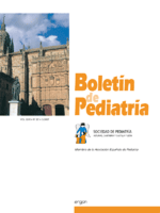Actualización en antibioterapia
M.E. Vázquez Fernández , M.R. Bachiller Luque , M.J. Vázquez Fernández , E. Pastor García , J.M. Eiros Bouza
Bol. Pediatr. 2007; 47 (201): 219 - 227
Objetivo: Se trata de un artículo de revisión que pretende una puesta al día en el problema de las resistencias bacterianas a los antibióticos, que todos los que desarrollan su actividad en el ámbito pediátrico deben conocer. Desarrollo: La resistencia a antibióticos es un problema de salud pública, que ha experimentado un elevado incremento en los últimos años, y España es uno de los países europeos más afectados. El consumo de antibióticos, especialmente elevado en población pediátrica, es la principal causa de este incremento. Los factores que determinan su consumo son variados: estilo de práctica médica, medicina defensiva, presión asistencial, automedicación, presión farmacéutica, políticas sanitarias, entre otros. Es necesario establecer estrategias que nos permitan reducir el impacto sanitario de las resistencias bacterianas. Conclusiones: El conocimiento de las tendencias evolutivas en el consumo y la situación de la resistencia a antibióticos debe ser el primer paso que nos permita evaluar el consumo realizado y examinar los factores que en él han intervenido, con el fin de concretar áreas de mejora en el uso de los antibióticos y valorar el efecto de determinadas intervenciones modificadoras y de contención. Abstract Objective: It is a question of an article of review that he claims a putting a day in the problem of the bacterial resistance to antibiotics, that all those who work with children must know. Development: Antibiotic resistance is a public health problem that has become increasingly acute in last years and Spain is one of the most affected European countries. Antibiotic consumption specially elevated in paediatric population, is the main cause of this emerging resistance. The determinants of antibiotic use are varied: style of medical practice, defensive medicine, welfare pressure, self-medication, pharmaceutical pressure, sanitary policies, among others. It is necessary to establish strategies that allow reducing the sanitary impact of the bacterial resistances. Conclusions: The knowledge of the tendencies in the consumption and the situation of the antibiotics resistances must be the first step that allows to evaluate the consumption and to examine the factors that have intervention, with the purpose of making specific areas of improvement in the antibiotic use and to value the effect of some modifiers and containment interventions.
\N
\N
Artículo completo (PDF) (125 kb.)
- Infectología
